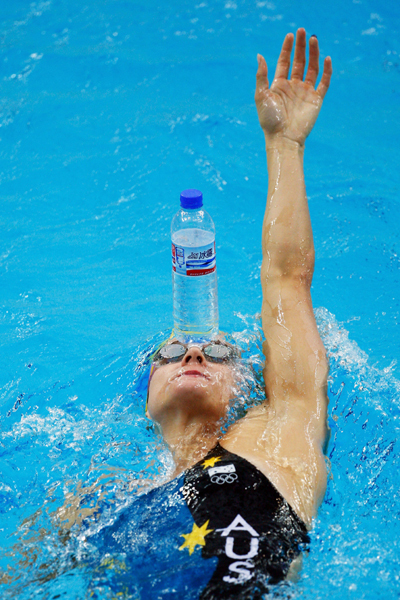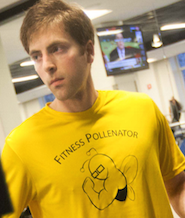“One Weird Trick” to Improve Exercise Technique Instantly: Proprioceptive Stimulus
Today’s guest post comes from Travis Pollen, a very accomplish athlete and recently completed a masters degree in biomechanics and movement science, so he’s definitely a sharp cookie. Well, as sharp as cookies can be, but I guess to be sharp it would have to be pretty old, and Travis isn’t really that old. Whatever, forget what I said and just read on, would you?
*****
Back in my swimming days, we typically did 200 laps, or 5,000 yards, every day. That’s the equivalent of nearly three miles. Sometimes we did even more.
But just like not every set in the gym is taken to all-out failure, not every lap in the pool was an all-out effort. That would be a sure-fire recipe for injury and overtraining. Instead, only about 2,000 of those yards were devoted to the “main set,” during which effort was near maximal.
And the other 3,000 yards? About 2,000 of them were generally devoted to warm-up and cool-down, leaving 1,000 yards for what we called “drills.”
In swimming, drills are used as a means of improving some technical aspect of the stroke by isolating it. For example, “fingertip drap” is a drill for freestyle in which the finger tips trace the surface of the water during the recovery in order to reinforce a high elbow position. Drills are usually carried out at slower speeds and with more rest than regular training to allow for increased focus and decreased fatigue.
As a backstroker, my favorite drill involved placing a water bottle on my forehead and trying to prevent it from tipping over as I swam. You see, many swimmers have a tendency to lift or rotate their head as the rest of their body moves. Since the body follows the head, it’s important that the head travels in a straight, level line down the pool. The purpose of this drill was to reinforce that rigid head position.

BEIJING – AUGUST 04: Sophie Edington of Australia attends a practice session at the National Aquatics Center at the 2008 Beijing Summer Olympics on August 4, 2008 in Beijing, China. (Photo by Cameron Spencer/Getty Images)
The somewhat surprising part is that most swimmers don’t even realize that their head is moving. Only when they put the water bottle on their forehead and struggle to keep it from capsizing do they become aware of the error.
Of course, that’s exactly why we use the water bottle: to bring awareness to something that’s difficult to feel. In fact, there’s even a fancy word for positional awareness of the body in space. That word is proprioception. Anything that aids proprioception, like the water bottle in this case, is called a proprioceptive stimulus.
In the pool, a typical protocol for drills would be to swim several laps with the water bottle, then remove the bottle and swim a few laps normally. The overarching goal of the drill is to have the improved bodily awareness carry over to the actual stroke even after the stimulus had been removed.
What the heck does this have to do with pumping iron?
Not surprisingly, drills and proprioceptive stimuli aren’t exclusive to swimming. In fact, they’re extremely useful in just about every sport and athletic pursuit, including strength training. In the gym, they’re perfect for folks with whom verbal cues like “flat back,” “chest up,” and “wrist stacked” just don’t jibe.
Below, I describe several examples of proprioceptive stimuli you can apply in the weight room. These drills serve to increase awareness of where the body is in space and can even elicit instant improvement in exercise technique.
- Dowel rod hip hinge
The “hip hinge” is utilized in a laundry list of exercises, including deadlifts, good mornings, kettlebell swings, and bent-over rows. During the hip hinge, a straight line must be maintained from the hips to the top of the head as the torso inclines forward. The knees should only flex and extend subtly (about 10 degrees) over the course of the movement.
Unfortunately, what we often see is spinal flexion, or a round back — even if the person feels as if their back is perfectly flat. The good news is that we can apply a proprioceptive stimulus in the form of a dowel rod (or broomstick) to clean that faulty movement right up.
Hold the rod in the small of the back and at the neck, and note the three points where the rod contacts the body: the back of the head, the mid/upper back, and the sacrum. Ensure all three contact points are maintained throughout the hip hinge before progressing to any of the above-mentioned exercises with added load.
- Wall-facing squats
In a squat, the goal is generally to maintain an upright torso position in order to work the quadriceps muscles. However, many squatters unknowingly perform “squat mornings” by allowing their torso to tip forward as they descend. This excessive forward lean takes away from the quad emphasis and can put undue stress on the lower back.
In order to know immediately whether you’re staying upright, set up a few inches away from a wall (facing the wall, with arms overhead) and squat. If you’re able to hit proper depth without grazing the wall, you’re good to go. If not, reposition yourself a few inches farther from the wall and try again. Over time, work to get closer to the wall.
- Squats with tape
When squatting under heavy load, it’s critical for back health to keep the pelvis tipped forward (in anterior pelvic tilt), as opposed to allowing it to tuck underneath at the bottom of the squat. The trouble is, it’s incredibly difficult to feel whether this so-called “butt wink” is occurring.
In this case, the proprioceptive stimulus comes in the form of a piece of tape applied at the intersection of the lower back and shorts (shirt optional). If you maintain proper anterior pelvic tilt, the tape will remain intact. If, on the other hand, the tape pulls off as you descend into the hole, it signifies butt wink.
- Kettlebell swings over a box
Kettlebell swings are one of the most butchered exercises in the history of exercises. (For one example, see Jillian Michaels Kettlebell Training.) Even if you’re not committing the fatal mistake of treating them like ballistic front raises, you may still be performing them with more of a squat than the previously-described hip hinge. That is, instead of pushing the hips back and allowing the torso to come forward, you maintain an upright torso and bend excessively at the knees.
The simple fix for this mistake is to place a box in between your legs during the swing. Perform the swing correctly, and the bell stays above the box. However, squat the swing, and the bell will hit the box. In place of a box, a cone may also be used.
[Note: As my friend and kettlebell aficionado James House astutely pointed out to me in the making of this post, there are other ways to correct a “squatty swing” besides having the person whack the kettlebell against a box.
First and foremost, James teaches full-body tension by having his clients lie supine and push into the floor. This is what the top of the swing should feel like, he explains, and the tension should be broken only at the last second by shoving the hips backwards, as opposed to allowing the bell to pull the person down into a squat.
Still, for a quick fix, especially in a group setting, the swing over a box can be a good solution.]
- Shoe Turkish get-ups
One of the many benefits of the Turkish get-up is improved stability of the shoulder in the overhead position. In order to transition from the ground to standing with a heavy weight overhead, that weight must be stacked directly over the wrist, which in turn must be stacked directly over the elbow, and shoulder, and so on. Muscular effort is significantly reduced when this alignment is optimized.
A quick and easy way to assess alignment is to perform a Turkish get-up not with a weight, but rather with a shoe. Place the shoe atop a closed fist, and do a get-up. If the shoe stays in place without sliding off, you know you’re doing it right.
- Crawl with a ball
Crawling is a fundamental movement that many of us never perform after the age of about one. Even when you do see crawling used as an exercise, it’s often in a bastardized form, where the hips are way up in the air and the goal is just to get from one place to another as fast as possible. This is a real tragedy, considering what a great core stability exercise crawling can be when done right (not to mention the quad burn!).
When crawling, in order to determine whether you’re keeping your hips level and resisting trunk rotation, place a ball in the small of your back. Don’t get discouraged if the ball continually rolls off over the course of a few yards. Each time that happens, your nervous system is reprogramming so as to avoid the same mistake in the future.
Cementing the Change
Applying proprioceptive stimuli to strength training is one of the fastest ways to elicit technique changes. After the drill, just remember to ditch the stimulus and return to the target exercise using load in order to make those changes stick. Note that in addition to the drills I discussed above, another trick for increasing sensory input is simply to train barefoot.
About the Author
Travis Pollen is an NPTI certified personal trainer and American record-holding Paralympic swimmer. He recently completed his Master’s degree in Biomechanics and Movement Science at the University of Delaware. He maintains a fitness blog and posts videos of his “feats of strength” on his website. Be sure to like him on Facebook and Twitter, as well.



9 Responses to “One Weird Trick” to Improve Exercise Technique Instantly: Proprioceptive Stimulus